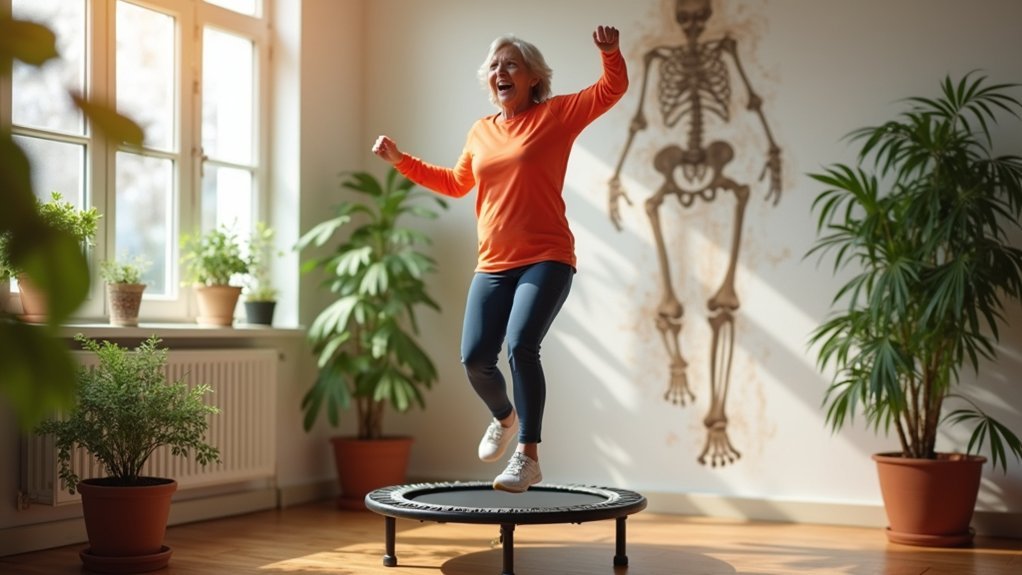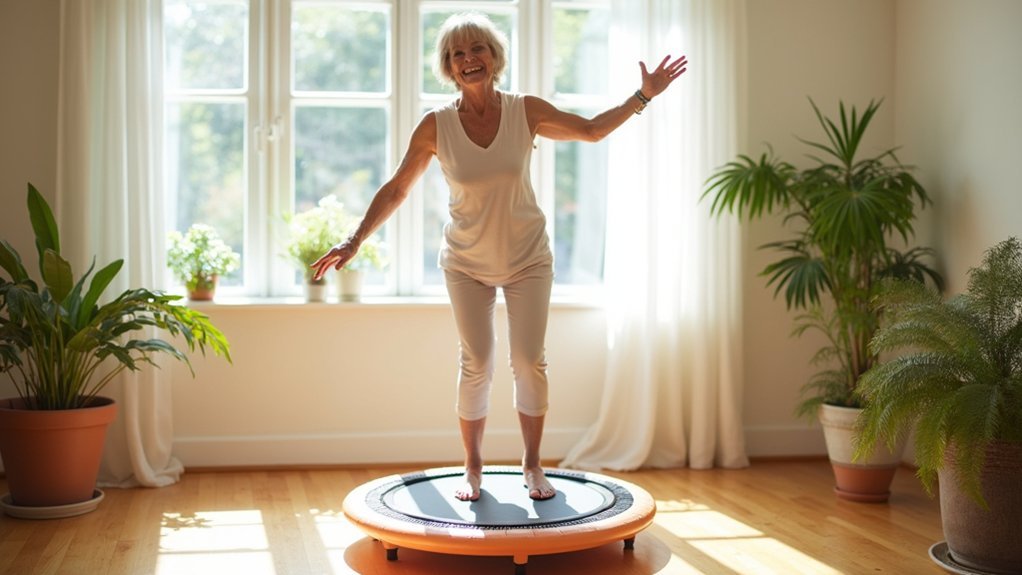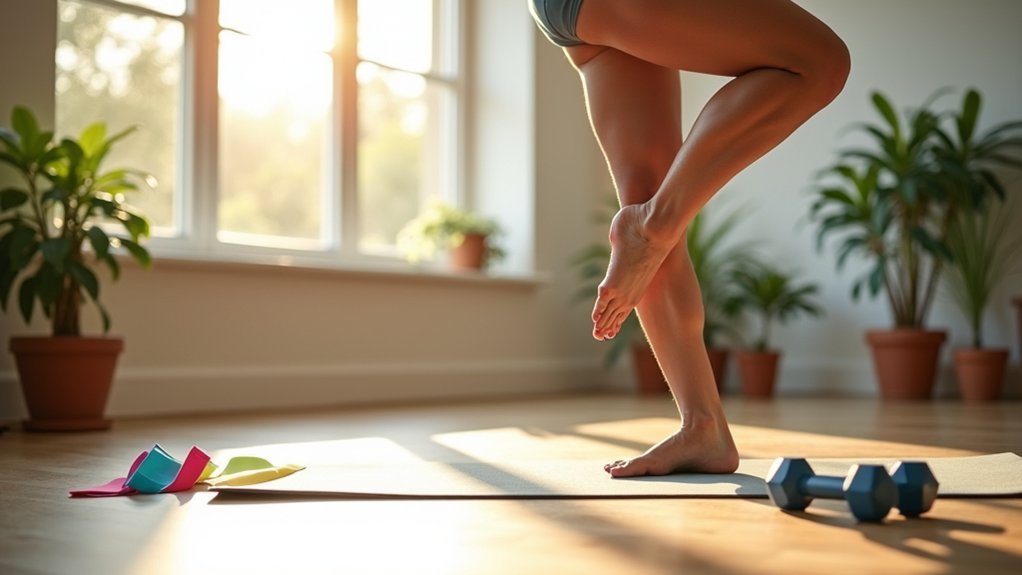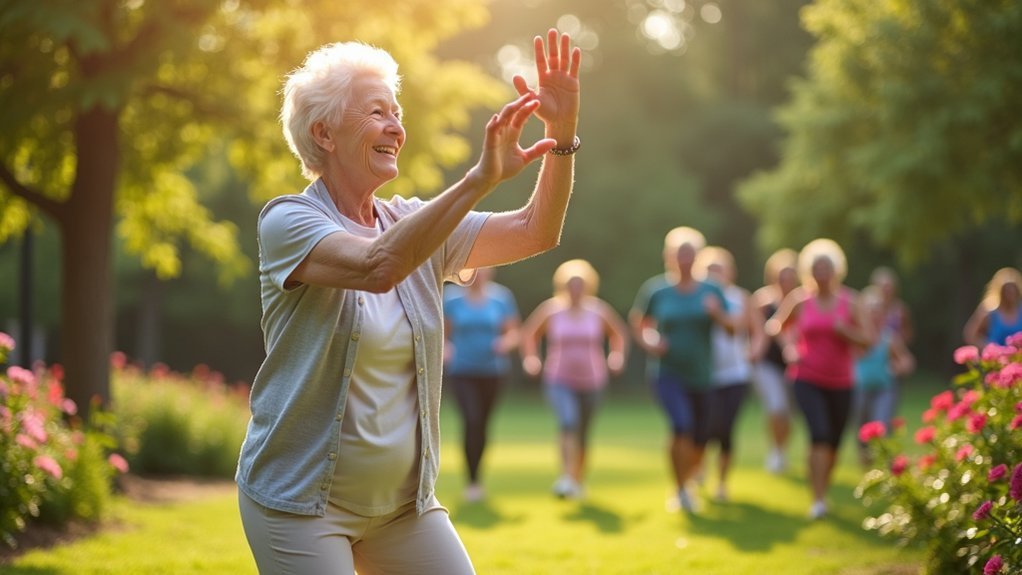Rebounding on a mini trampoline is perfect for strengthening bones after menopause. Just 10-15 minutes daily creates weight-bearing stress that stimulates bone formation without jarring your joints. Start with gentle bounces for 1-2 minutes, gradually building to 20-30 minutes three times weekly. This low-impact exercise also improves balance, reducing fall risk, while engaging multiple muscle groups. Pair with strength training for maximum bone density benefits. Your skeleton will thank you for bouncing into better health.
The Science Behind Rebounding for Bone Health

While many women face declining bone density after menopause, rebounding offers a scientifically-backed solution to this common challenge. The mini-trampoline’s bouncing motion creates weight-bearing stress that stimulates bone remodeling, essential for fighting osteoporosis.
When you rebound, the repetitive jumping engages multiple muscle groups that pull against your skeletal structure, encouraging osteoblast activity. This bone-building process helps increase mineral density and strength where you need it most.
Research shows significant improvements in bone health among postmenopausal women who participate in high-impact exercises like rebounding.
Studies confirm: rebounding strengthens bones in postmenopausal women, offering a powerful defense against age-related bone loss.
Beyond bone density benefits, you’ll improve balance and coordination, reducing fall risks—crucial for anyone experiencing age-related bone loss. Just 10-20 minutes of rebounding several times weekly supports bone health while enhancing cardiovascular fitness simultaneously.
How Menopause Affects Your Skeletal System
Your body experiences significant bone changes as estrogen levels plummet during menopause, triggering an imbalance where bone breakdown outpaces bone formation.
This hormonal shift accelerates calcium loss from your bones, with up to 20% of bone mass potentially disappearing within the first five to seven years after menopause.
Understanding these skeletal changes is vital because your increased osteoclast activity directly increases your fracture risk, making preventive bone-strengthening measures essential during this life change.
Hormonal Decline’s Bone Impact
When estrogen levels plummet during menopause, they trigger a cascade of changes in your skeletal system that can greatly weaken your bones. Your body experiences a rapid hormonal decline that disrupts the balance between bone formation and breakdown.
Without sufficient estrogen, osteoclasts become overactive, accelerating bone resorption while new bone creation lags behind.
You’re facing a critical window for bone health as you may lose up to 20% of your bone density within 5-7 years post-menopause, considerably increasing your osteoporosis risk.
- Your skeleton loses strength faster than at any other time in your adult life
- Fracture risk rises dramatically as bone architecture weakens
- Spine, hips, and wrists become particularly vulnerable to breaks
- Regular weight-bearing exercise becomes essential to counteract these effects
Accelerated Calcium Loss
As estrogen levels plummet during menopause, calcium rapidly departs from your bones, entering your bloodstream and eventually leaving your body through urination. This accelerated calcium loss can dramatically reduce your bone mineral density, leaving you vulnerable to fractures from even minor impacts.
During the first 5-7 years post-menopause, you may lose up to 20% of your bone mass. This rapid decline occurs because without sufficient estrogen, osteoclasts (bone-breaking cells) become overactive, while bone-building processes slow down.
You’ll likely progress through osteopenia (early bone loss) before potentially developing osteoporosis. Your bone strength deteriorates most quickly when you’re least expecting it.
Since peak bone mass typically develops by age 30, starting preventative measures early is essential. Don’t wait for symptoms to appear—by then, significant calcium loss has already occurred.
Benefits of Low-Impact Rebounding for Fragile Bones

Despite its playful appearance, rebounding on a mini-trampoline offers serious benefits for women with fragile post-menopausal bones. This gentle weight-bearing exercise stimulates osteoblast activity, counteracting the accelerated bone loss you’re experiencing.
- Strengthens bones without stressing your low back or joints, making it ideal for those with osteoporosis concerns.
- Improves balance and coordination, reducing your fall risk—a significant factor when bone density is compromised.
- Enhances circulation and muscle strength, both essential components for maintaining bone health.
- Requires just 10-15 minutes daily to see meaningful improvements in bone resilience.
The vertical movements create just enough force to encourage bone remodeling while protecting your skeletal system from jarring impacts.
You’ll build bone density while enjoying a workout that feels more like play than exercise.
Getting Started: Choosing the Right Rebounder
When selecting a rebounder to support your post-menopausal bone health, consider both the size and space available in your home, as a standard 36-40 inch diameter provides adequate bouncing surface while remaining storage-friendly.
While budget-friendly options exist, investing in a higher-quality rebounder with bungee cords rather than springs can offer a gentler impact on fragile joints and typically provides greater durability over time.
You’ll want to guarantee your chosen model supports at least 250-300 pounds and features sturdy construction with non-slip surfaces to maximize safety during your bone-strengthening workouts.
SIZE MATTERS
Three critical dimensions deserve your attention when selecting a rebounder for bone-strengthening exercise after menopause.
When dealing with osteoporosis concerns, size truly affects both safety and effectiveness. Choose a model with at least a 36-inch diameter jumping surface to properly perform balance exercises and strength training movements without risking falls.
Consider these key dimensional factors:
- Height: Select a rebounder 8-12 inches off the ground for ideal low-impact exercise while maintaining safety.
- Diameter: A 36-inch (or larger) surface accommodates a variety of movements and proper foot positioning.
- Adjustability: Look for models with variable tension settings to customize resistance as your strength improves.
- Stability: Verify the frame is sturdy with non-slip feet to prevent shifting during intense exercise sessions.
QUALITY VS. PRICE
Finding the right balance between quality and price represents the next key decision after determining your ideal rebounder dimensions. Higher-quality rebounders typically feature more durable frames and springs that maintain elasticity even with regular use.
| Price Range | Quality Features | Safety Benefits |
|---|---|---|
| Budget | Basic frame | Minimal stability |
| Mid-range | Better springs | Enhanced balance support |
| Premium | Reinforced frame | Maximum stability |
| Professional | Heavy-duty materials | Superior safety features |
| Therapeutic | Medical-grade components | Fall prevention design |
When evaluating options, consider weight capacity that exceeds your own weight to guarantee safety during your bone-strengthening exercises. User reviews can provide valuable insights into performance and longevity. While premium models cost more, they often deliver improved stability and safety features that protect your joints—particularly important for post-menopausal bone health.
10-Minute Gentle Bouncing Routine for Beginners

A simple one-minute bouncing routine can revolutionize your bone health after menopause. This gentle bouncing stimulates bone density through low-impact, weight-bearing movement that activates osteoblasts—the cells responsible for bone formation.
You don’t need special equipment, making this perfect for beginners concerned about maintaining bone health.
- Start with small, controlled bounces while keeping your posture straight
- Incorporate just 60 seconds of bouncing several times throughout your day
- Focus on maintaining balance to reduce fall risks common for postmenopausal women
- Gradually increase intensity as your comfort level improves
This accessible exercise helps combat the effects of declining estrogen levels without putting undue stress on your joints.
It’s an effective strategy to strengthen your skeletal system when you’re most vulnerable to bone loss.
Progressive Rebounding: Building Strength Week by Week
Start your rebounding journey with just 1-2 minutes of gentle bounces, focusing on maintaining balance rather than height.
You’ll build confidence by adding 30 seconds each week and tracking improvements in your stability, endurance, and ability to incorporate more complex movements.
As you progress through the weeks, you’ll notice not only stronger bones but also better coordination and balance—crucial factors in preventing falls that often lead to fractures.
Start Low, Progress Gradually
Three key principles guide effective rebounding for postmenopausal women: gentle initiation, consistent progression, and proper form.
When beginning your exercise program, start low with basic bouncing movements that allow your body to adjust while still stimulating bone density improvement.
As you gain confidence, progress gradually by extending your sessions from 5-10 minutes to the recommended 20-30 minutes, 2-3 times weekly. Listen to your body’s signals and adjust accordingly.
- Begin with gentle bounces keeping both feet on the rebounder
- Add side-to-side movements once you’ve mastered basic bouncing
- Incorporate arm movements to enhance full-body engagement
- Track your progress weekly, noting improvements in balance and stamina
This measured approach guarantees your bone-strengthening journey remains safe, effective, and sustainable throughout post-menopause.
Track Weekly Improvements
Measuring progress through weekly tracking forms the cornerstone of successful rebounding for bone health. By documenting your sessions, you’ll notice incremental improvements in your strength and bone density that might otherwise go unnoticed.
| Week | Duration (mins) | Exercise Type | Progress Notes |
|---|---|---|---|
| 1 | 10 | Basic bounces | Establishing baseline |
| 2 | 12 | Side-to-side hops | Improved balance |
| 3 | 13 | Forward jumps | Less fatigue after session |
| 4 | 15 | Mixed movements | Noticeable strength gain |
| 5 | 15 | All varieties | Increased repetitions |
Even 10-15 minutes daily of varied rebounding exercises delivers significant benefits. The gentle impact stimulates bone growth while improving cardiovascular health. Challenge yourself with different movements—side hops, forward jumps—to thoroughly strengthen your skeletal system. Your weekly log becomes both motivational tool and personalized guide for adjusting intensity according to your body’s responses.
Combining Rebounding With Strength Movements
While rebounding on a mini-trampoline offers excellent low-impact benefits for bone health, combining it with strength movements creates a powerful synergy that can greatly boost your post-menopausal bone density.
This combination delivers both the osteoblast-stimulating bouncing and the muscle-building effects of resistance training.
- Try bouncing for 1-2 minutes, then step off to perform 10-15 squats or lunges.
- Add hand weights during gentle bouncing to increase upper body resistance.
- Incorporate balance challenges by performing single-leg stands on the trampoline between strength sets.
- Follow a 20-minute rebounding session with resistance band exercises to maximize bone-building benefits.
You’ll notice improved coordination and balance as you progress, reducing your fall risk while strengthening both your muscles and bones simultaneously.
Measuring Your Bone Density Progress
As you build strength through rebounding and resistance training, tracking your bone health becomes an essential part of your post-menopausal wellness journey.
The gold standard for measuring bone density is a DEXA scan, which provides T-scores that reveal your bone mass compared to healthy young adults.
Schedule regular DEXA scans every 1-2 years to monitor your progress. A T-score above -1.0 indicates normal bone density, while scores between -1.0 and -2.5 suggest osteopenia, and below -2.5 confirm osteoporosis.
Maintain a detailed log of your exercise routine alongside your bone density measurements. This record helps demonstrate how consistent weight-bearing activities contribute to improvements in bone health.
Your documented progress won’t only validate your efforts but also motivate you to sustain the exercise habits that strengthen your bones.
Safety Precautions for Rebounding After 50
Three key safety measures should guide your rebounding journey after 50.
First, consult your healthcare provider about your bone health, especially if you’ve been diagnosed with osteoporosis.
Second, invest in a quality fitness trampoline with proper padding and support.
Third, progress gradually with low-impact movements as your body adapts to this new exercise.
- Start with just 5-10 minutes of gentle bouncing, slowly increasing duration as your confidence grows.
- Focus on maintaining proper form—keep knees slightly bent and land softly.
- Incorporate balance and stability exercises before and after rebounding sessions to reduce fall risk.
- Position your trampoline near a wall or stable furniture for support if you’re concerned about stability.
Success Stories: Women Who Reversed Bone Loss
Real-life success stories offer powerful inspiration for women concerned about bone health after menopause. Many have transformed their diagnosis of osteoporosis in postmenopausal women into a success story through dedicated exercise regimens.
Take Sarah, who reversed significant bone loss by committing to weight-bearing exercises three times weekly. Her program of squats, lunges, and resistance training stimulated new bone formation, moving her from osteopenia to normal bone density in 18 months.
Similarly, Janet incorporated rebounding and strength training into her routine, reporting a 3.2% increase in hip density after just one year.
These women credit their success to exercises that strengthen both bones and surrounding muscles, improving balance and reducing fracture risk.
With proper guidance and community support, you too can build strong bones after menopause.
Creating a Sustainable Rebounding Schedule
While enthusiasm often runs high when starting a new exercise routine, maintaining consistency with rebounding requires thoughtful planning. Aim for 2-3 sessions weekly, each lasting 20-30 minutes, to effectively build bone strength post-menopause.
- Start with low-impact bounces and gradually increase intensity as your fitness level improves.
- Mix different movements like gentle bounces, side-to-side hops, and mini squats to engage various muscle groups.
- Track each session’s duration and intensity, making adjustments based on how your body responds.
- Guarantee safety with supportive footwear and a stable rebounding surface.
Remember that consistency trumps intensity when building bone density. Even shorter, regular rebounding sessions can stimulate osteoblast activity needed for stronger bones, making this exercise sustainable for your long-term health.
When to Consult Your Doctor About Exercise and Bone Health
How do you know when your bone health concerns require professional guidance?
Always consult your doctor before starting any new exercise program, especially if you’ve been diagnosed with osteoporosis or osteopenia. This preventative step guarantees your activities support rather than compromise your bone health.
Seek medical advice immediately if you experience pain during exercise or struggle with daily activities.
Women with previous spinal fractures should prioritize professional guidance to identify safe, low-impact options tailored to their condition.
Regular bone density tests and check-ups help monitor your progress and allow for timely exercise modifications.
Don’t overlook the impact of coexisting conditions like arthritis, which may require additional adjustments to your routine.
Your doctor can help create an exercise plan that strengthens bones without increasing fracture risk.
Frequently Asked Questions
How to Build Strong Bones After Menopause?
You’ll strengthen bones after menopause by performing weight-bearing exercises and resistance training 2-3 times weekly. Don’t forget high-impact activities like dancing, and practice balance exercises such as tai chi to prevent falls.
Can You Rebuild Bone Density With Exercise?
Yes, you can rebuild bone density through exercise. Weight-bearing and resistance training stimulate bone formation, while high-impact activities lead to significant improvements. Regular muscle-strengthening workouts 2-3 days weekly effectively counteract bone loss and increase density.
What Is the Fastest Way to Increase Bone Density?
To increase bone density fastest, you’ll need high-impact exercises like jumping combined with progressive resistance training. Don’t forget to complement your efforts with sufficient calcium and vitamin D in your daily diet.
Is Walking 2 Miles a Day Good for Osteoporosis?
Yes, walking 2 miles daily benefits osteoporosis by promoting bone remodeling, improving density, and enhancing muscle strength. It’s a weight-bearing exercise you can easily adjust to your capabilities while reducing fall risks.
In Summary
You’ve now got everything you need to strengthen your bones through rebounding. Start with just 10 minutes daily and you’ll feel the difference in your balance and energy. Listen to your body, adjust as needed, and celebrate small victories. Remember, it’s never too late to improve your bone density. Your future self will thank you for the mini-bounces you’re taking today.



Leave a Reply